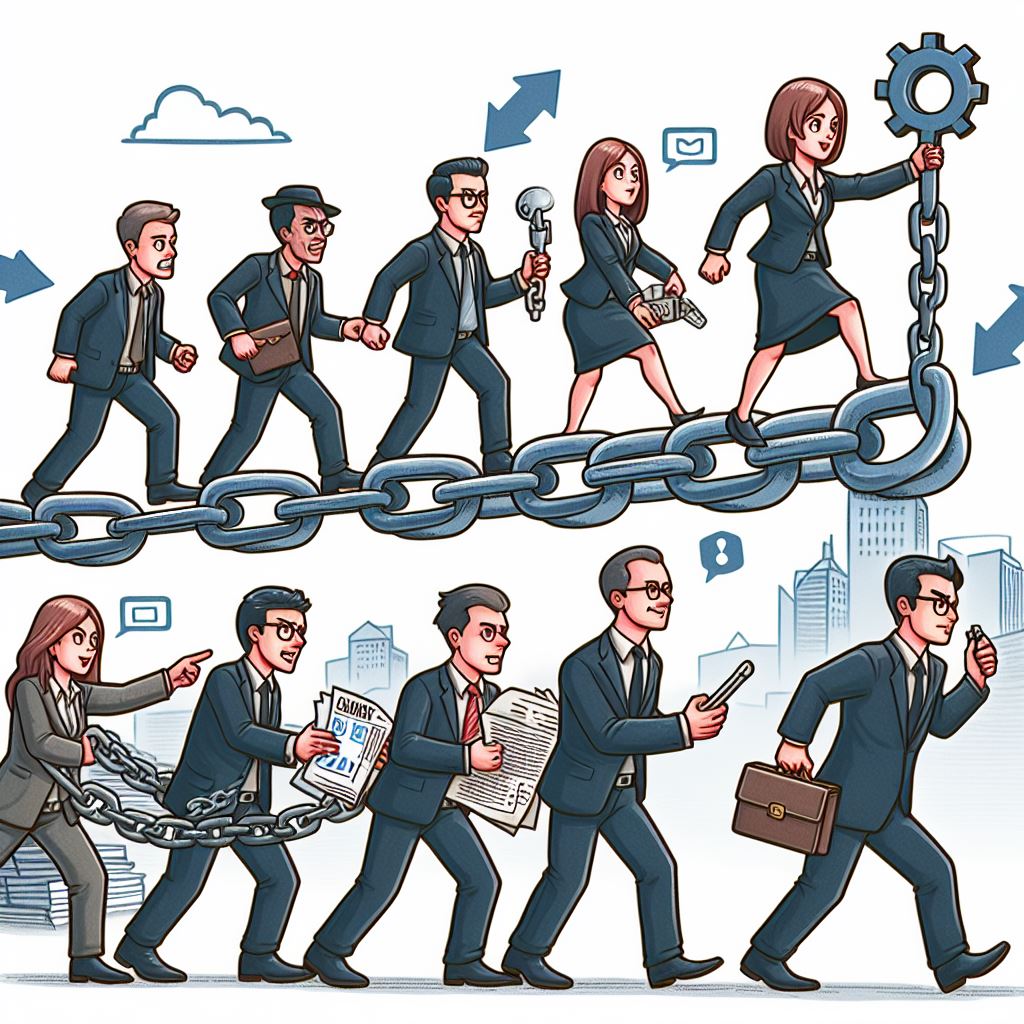Estimated reading time: 8 mins
In any organization, large or small, the chain of command is a fundamental concept that outlines the hierarchy of authority and responsibility. It is a system that ensures efficiency, clarity in communication, and effective management. Despite the evolving nature of workplaces and management styles, the chain of command remains a crucial element in the structure of modern organizations. This post will delve into what the chain of command is and why it continues to hold significance today.
Understanding the Chain of Command

The chain of command is a term borrowed from the military, where it is quintessentially exemplified. It refers to the formal line of authority, moving from the top echelons of the organization down to the lower ranks. In a corporate context, it typically starts with the board of directors at the top, followed by the CEO or president, then the senior executives, middle managers, and finally the base-level employees.
The structure is not just about who reports to whom. It is about how information flows, how decisions are made and executed, and how accountability and responsibility are allocated. The clarity provided by a well-defined chain of command helps to ensure that everyone in the organization understands their role, knows who they can report to, and understands who holds responsibility for different decisions and actions.
The Relevance of Chain of Command Today
1. Clarity in Decision-Making:
In today’s dynamic business environment, the ability to make quick and effective decisions is crucial. The chain of command plays a pivotal role in ensuring clarity in the decision-making process. By establishing a clear hierarchy of authority, it delineates who has the power to make which decisions. This clarity is vital for several reasons.
Firstly, it prevents the confusion and paralysis that can occur when it’s unclear who is authorized to make decisions. In the absence of a defined chain of command, organizations can suffer from decision-making bottlenecks where employees, unsure of their decision-making authority, defer to others or avoid making decisions altogether. This can lead to critical delays and missed opportunities.
Secondly, a clear chain of command ensures that decisions are made by those with the most knowledge and experience in the relevant areas. This alignment enhances the quality of decisions, as they are made by individuals who understand the strategic objectives of the organization and the specifics of the situation at hand.
Finally, this structure facilitates a top-down flow of decisions that are in line with the organization’s overall strategy and objectives. Employees at all levels understand that decisions are made within a framework that supports the organization’s goals, leading to a more focused and unified effort in achieving them. This streamlined decision-making process, guided by a clear chain of command, is a fundamental driver of efficiency and effectiveness in any organization.
2. Efficiency in Communication:
In the realm of organizational management, the importance of communication cannot be overstated. The chain of command plays a pivotal role in ensuring communication is not just effective, but also efficient. By establishing a clear hierarchy, it delineates the pathways through which information should flow, from the highest levels of leadership to the frontline employees. This structure is instrumental in eliminating ambiguities and ensuring that messages are relayed accurately and promptly.
When communication cascades down a well-defined chain of command, it minimizes the risk of distortion or dilution of the message, which is a common problem in less structured communication networks. It ensures that everyone receives the same information, thereby fostering uniformity in understanding and response across the organization. This streamlined communication is crucial, especially in situations requiring swift action or in crisis management, where the accuracy and speed of information dissemination are vital.
Moreover, a clear chain of command also supports upward communication. Employees know exactly whom to approach with feedback, ideas, or concerns, making them more likely to share valuable insights. This upward flow of information is crucial for organizations to adapt, innovate, and grow. It provides leaders with ground-level insights, enabling informed decision-making and strategy formulation. Thus, the chain of command, by ensuring efficient communication, serves as the backbone of organizational coherence and dynamism.
3. Accountability and Responsibility:
A crucial aspect of the chain of command is its delineation of accountability and responsibility, a system that is fundamental to the integrity and efficiency of any organization. Within this framework, each level of the hierarchy is clearly responsible for specific decisions, actions, and outcomes. This clear demarcation of responsibility ensures that tasks are completed as expected, and goals are systematically pursued.
The chain of command also establishes a direct line of accountability. When a project succeeds or fails, it is clear who should be praised or who needs to provide explanations. This clarity discourages the passing of blame and encourages ownership of tasks among employees. Employees, knowing that they are accountable for their actions, are more likely to be conscientious and detail-oriented in their work.
Furthermore, this structured accountability facilitates effective problem-solving. When issues arise, it is easier to identify the source and address it promptly, as the responsibility for each aspect of the work is well-defined. Leaders can quickly pinpoint areas of concern and direct their attention where it is most needed, thereby streamlining the process of organizational problem-solving.
This system of accountability and responsibility, therefore, is not just about maintaining control and order. It is also about empowering employees through clear expectations and the assurance that their contributions are recognized and valued within the organizational framework. It fosters a culture of responsibility, where each member of the organization understands their role and its impact on the broader organizational goals.
4. Organizational Discipline and Order:
One of the most significant roles of the chain of command is in establishing and maintaining organizational discipline and order. This aspect is particularly critical as it forms the backbone of operational integrity and professionalism within an organization. A well-defined chain of command delineates clear lines of authority and responsibility, which are essential for maintaining discipline. Employees are more aware of their roles, responsibilities, and the boundaries within which they are expected to operate. This awareness is crucial in preventing chaos and confusion, especially in high-stress situations or during complex projects.
Moreover, the chain of command is instrumental in enforcing company policies and procedures. It ensures that rules are not just suggestions but directives that need to be followed. When employees understand that there is a structured hierarchy observing and ensuring compliance, there is a natural inclination towards adhering to established guidelines and protocols. This compliance is not about fostering a rigid work environment but about creating a space where order and predictability prevail. Such an environment is conducive to productivity and helps in mitigating risks associated with non-compliance and indiscipline.
In essence, the chain of command serves as the skeleton that holds the organization together, giving it the structure and strength needed to function effectively and efficiently. It’s a balancing act between authoritative control and empowering employees to perform their duties within a well-defined framework.
5. Employee Morale and Job Satisfaction:
A well-defined chain of command significantly impacts employee morale and job satisfaction, elements crucial for a productive and positive workplace. When the hierarchy is clear, employees understand their roles, responsibilities, and to whom they report. This clarity eliminates confusion and reduces workplace conflicts, as employees are less likely to feel overstepped or undermined by their peers. It fosters an environment where everyone knows their place and value within the organization, contributing to a sense of security and belonging.
Moreover, a clear chain of command also establishes transparent pathways for career progression and personal development. Employees can see a direct correlation between their performance, the recognition they receive, and their advancement opportunities within the organization. This visibility can be incredibly motivating, encouraging employees to strive for excellence and take initiative.
Additionally, when employees understand the chain of command, they feel more empowered to voice their concerns and provide feedback, knowing exactly who to approach. This sense of empowerment is critical for job satisfaction, as it makes employees feel heard and valued. In turn, this can lead to increased loyalty, lower turnover rates, and a stronger, more cohesive team dynamic.
Ultimately, the chain of command, when implemented with consideration and respect for all levels of staff, can lead to a more engaged, motivated, and satisfied workforce, driving the organization’s success and fostering a positive work culture.
Challenges and Modern Adaptations


While the chain of command is undoubtedly beneficial, modern organizations often face challenges in implementing it effectively. The rise of flat and flexible organizational structures, especially in startups and tech companies, has led to a more collaborative and less hierarchical approach. This evolution calls for a balance between maintaining a chain of command and fostering a culture of open communication and collaboration.
In response, many organizations are adapting the concept to fit their unique cultures and operational needs. They maintain a chain of command for critical decision-making and accountability purposes, while encouraging open communication and collaboration across different levels of the hierarchy. This hybrid approach seems to be an effective solution for many modern businesses.
Conclusion
In conclusion, the chain of command remains a relevant and significant element in the structure of contemporary organizations. Its importance lies in bringing clarity, efficiency, accountability, discipline, and a sense of order in the management and operational processes. However, the changing nature of work environments necessitates that this concept be adapted and flexibly applied to suit the unique needs and cultures of different organizations.
The key to harnessing the full benefits of the chain of command in the modern workplace lies in striking the right balance between hierarchical structure and collaborative flexibility. By doing so, organizations can ensure that they are well-equipped to face the challenges of the ever-evolving business landscape.
